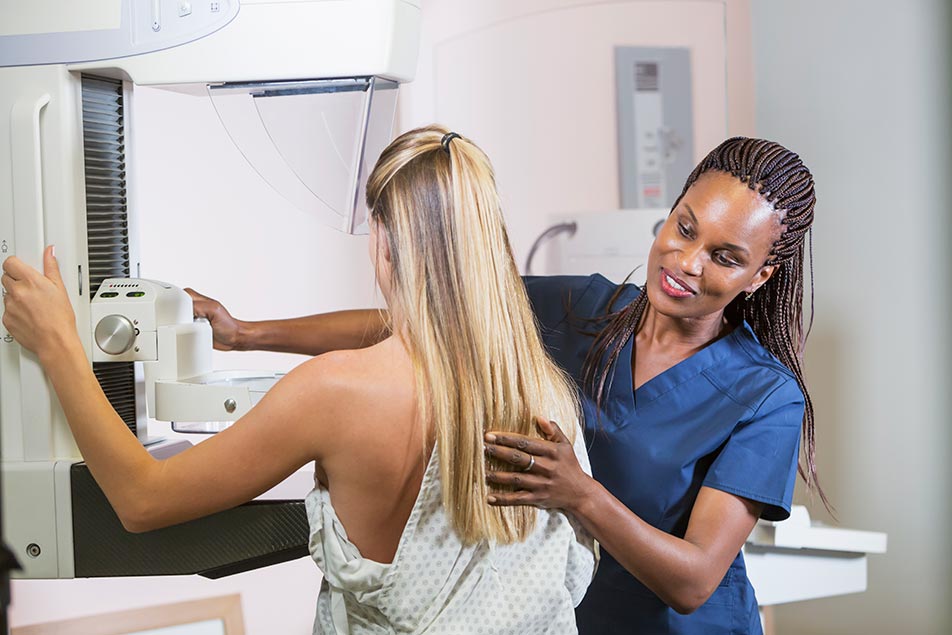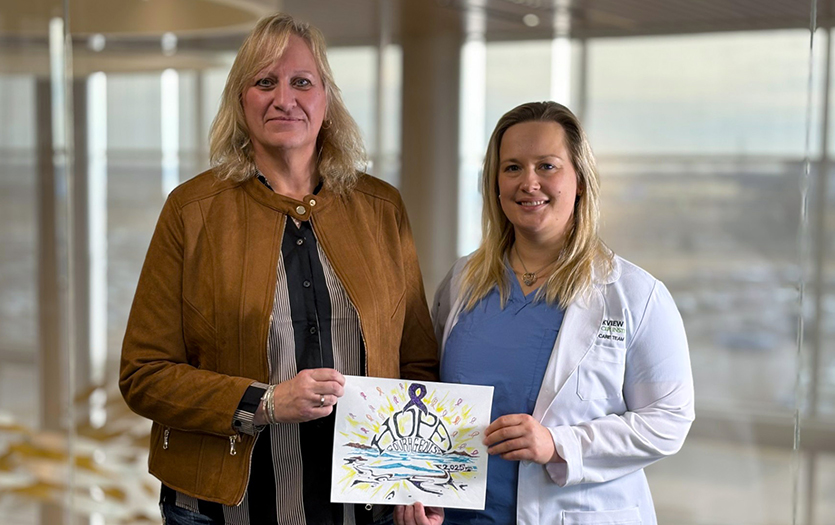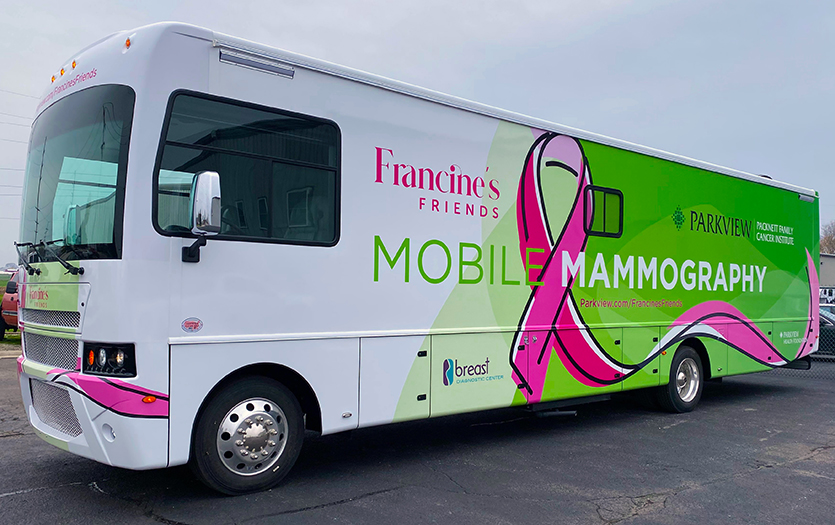
This post was written by Breck Hunnicutt, NP-C, CGRA, High Risk and Cancer Risk Reduction Clinic, Parkview Cancer Institute.
In the United States, breast cancer is the most common cancer in women after skin cancer. Breast cancer can be diagnosed in both men and women; however, it is much more common for females. One out of every eight women will develop breast cancer in her lifetime, which is considered average risk for a woman in the U.S.
Who is high risk?
A high-risk status for breast cancer is defined as greater than or equal to 20% lifetime risk or a one in five chance of developing breast cancer over a lifetime.
The risk for breast cancer depends on your individual medical history, family history and possible genetic profile. A "high-risk" determination can be concluded by one or more of the following factors:
- Family history of breast and ovarian cancer. The risk increases if there are multiple relatives on the same side of the family with a breast or ovarian cancer, or if a relative is diagnosed with multiple cancers including more than one breast cancer or breast and ovarian cancer. The risk also increases if a family member is diagnosed with breast cancer before the age of 50 or ovarian cancer at any age. This risk can be inherited from your mother or father's side of the family.
- Genetic mutations. You're at a higher risk if you have a family member with a pathogenic gene variant, which may include any of the following genes: BRCA1, BRCA2, ATM, BARD1, CDH1, CHEK2, NF1, PALB2, PTEN, RAD51Cm RAD51D, STK11 and TP53. Individuals with hereditary risk for breast cancer may have up to a greater than 60% lifetime breast cancer risk.
- History of abnormal breast biopsy. Atypical cells may indicate a higher risk of breast cancer. The most common high risk biopsy results include atypical ductal hyperplasia, lobular carcinoma in situ, atypical lobular hyperplasia, flat epithelial atypia, radial scar, papillary and phyllodes tumor. A biopsy with one of these results increases the chance of breast cancer.
- Dense breasts. Breasts comprised of more connective and glandular tissue and less fatty tissue have been associated with higher cancer risks.
- A high body mass index (BMI). It has been reported a BMI over 25 contributes to 60% of all cancer diagnoses. BMI is not the only indication of being overweight, as everyone has a unique build with consideration to the ratio of muscle and fat mass.
- Increasing age. The chance of developing a breast cancer increases with age. At ages 40 to 50, 1 out of every 69 women will be diagnosed with breast cancer, and at age 60 to 70, 1 out of every 29 women will be diagnosed with breast cancer.
- History of chest wall radiation at a young age. Radiation therapy at higher doses, including a large area of the chest, increases the lifetime risk of developing a breast cancer.
Should I consider genetic testing?
If you're considering genetic testing, the first step is to collect family information. Family history of cancer should include only blood relatives on both sides of the family, such as parents, siblings, aunts, uncles, cousins, grandparents and great-grandparents if possible. The history of each person should consist of the following:
- What kind of cancer, if a cancer was diagnosed?
- How old was the family member at diagnosis?
- What is the current age of the family member now or at death?
- As many details about the cancer as possible, including stage of cancer if known.
- Family ethnicity. Some ethnicities have a greater risk of certain cancers, such as Ashkenazi Jewish ancestry.
- Has anyone else in the family had genetic testing? If there is a family history of genetic testing, it is helpful to know when the testing was completed and what were the results.
It can be difficult to obtain a family history of cancer, as some people find it difficult to discuss or some relatives are hard to locate or deceased. It may be helpful to let the family members know what information is needed ahead of the conversation and to emphasize even a little information can be helpful. You could contact an older relative who may have more information about distant relatives. Facebook can also be a helpful tool when relatives are scattered in many different parts of the world. It is most helpful to bring a copy of personal genetic results if applicable.
The genetic testing process
A genetic counselor will review the pedigree and assess personal cancer risk. Genetic testing may be suggested. If testing is recommended, the counselor will provide testing options including how many genes to test, risks and benefits of testing, possible costs of testing, insurance implications and possible results.
Once testing is completed and results are obtained, the personal and family cancer risk will be reviewed with a plan presented for screening and cancer risk reduction. If there is a pathogenic gene variant found, the risk of cancer will most likely consist of more than one cancer risk.
What if my genetic testing is negative, but there is a family history of breast cancer?
A genetic variant is the least common cause of a cancer occurring, but provides the most information personally and to the family members, if present. It has been found about 5-10% of all cancers are due to a pathogenic gene variant, approximately 15-20% of cancers are due to family history and about 75% are sporadic or associated with personal characteristics and environmental factors.
In order to evaluate cancer risk and provide a screening plan with risk reduction, the provider will obtain a history, which may include the following questions:
- Has a breast biopsy ever been completed and what were the results? A copy of the result is most helpful.
- If breast imaging has been completed in the past, when was the date of the last breast imaging? At what facility was imaging completed?
- Has a hysterectomy ever been completed and do the ovaries remain?
- At what age was the first live delivery?
- At what age did menstrual cycles begin?
- Was hormonal replacement therapy taken, at what age, and how long was the hormone taken?
- What is the current menopausal status?
Once this information along with family history of breast and ovarian cancer is obtained, it is then placed in validated risk tools, which calculate the lifetime risk, 5-year risk, and 10-year risk of developing a cancer based on the specific information.
What screening may be considered for breast cancer risk due to a pathogenic gene variant or a calculated breast cancer risk?
Screening may consist of enhanced breast imaging every 6 months and a clinical breast exam. The imaging may include:
- Annual mammogram (3D or 2D) - A 3D mammogram combines multiple breast x-rays to create a three-dimensional picture of the breast. A 3D mammogram is recommended.
- Annual breast MRI (magnetic resonance imaging) - This uses radio waves and strong magnets to make detailed pictures of the inside of the breast. This type of imaging may locate some small breast lesions at times missed by other screening methods.
- Contrasted enhanced mammogram - This technology utilizes intravenous iodine-based materials to enhance the visualization of tumor neovascularity. It provides a low energy image and iodine image, which can increase the accuracy of the mammogram.
When certain gene variants are present or the risk model indicates a greater than 20% lifetime risk, screening can include an annual mammogram and an annual breast MRI. The imaging can alternate every 6 months along with every 6-month clinical breast exam.
What are some prevention and risk reduction strategies?
While not all risk factors can be modified, all women can decrease the risk of cancer as much as possible by choosing the healthiest lifestyle options including:
- Limit alcohol intake to no more than one drink a day, as even small amounts can increase risk.
- Maintain a healthy weight. If weight loss is needed, discuss with a health care professional the strategies needed to lose weight for all lifestyles.
- Being physically active may include daily walks. It is important to choose activity which is appropriate to an individual.
- Breastfeeding may decrease the risk of breast cancer.
- Limit post-menopausal hormone replacement therapy. It is important to discuss risks and benefits with a health care provider. Non-hormonal therapy may manage symptoms without the need for hormonal replacement. If hormonal replacement is utilized, it is important to use a low dose for a short period of time with careful monitoring.
- Get annual mammogram screenings.
What can be done to help prevent breast cancer if a pathogenic gene variant is present, or a calculated breast risk is above normal?
There are prevention strategies in the case of certain pathogenic gene variants. There are also prevention strategies for an increased breast risk, calculated by a breast risk model. These can include:
- Chemoprevention consisting of endocrine therapy may be used for individuals with an increased 5-year risk of breast cancer. The exact medication will depend on personal risk factors and menopause status.
- Risk reduction surgery consisting of bilateral mastectomies with or without reconstruction may be considered in the presence of certain gene mutations.
- If the pathogenic gene variant includes an ovarian cancer risk, removal of both ovaries may be considered.
The use of preventative surgeries or medications is a joint decision, which may or may not be implemented.
In all cases of cancer risk, the decision of risk reduction, screening, and prevention is a personal choice which involves a conversation between a patient and provider.
Interested in scheduling your mammogram
Direct scheduling of your annual mammogram is available through MyChart. Breast Diagnostic Center, Parkview hospitals and Parkview Cancer Institute locations now offer this convenient option for women due for their annual mammogram. Schedule now
The Francine's Friends Mobile Mammography coach brings 3D screening mammograms to local communities, offering convenience and privacy for this important screening test. To learn more about the Francine's Friends Mobile Mammography coach and view it's current schedule, click here.



